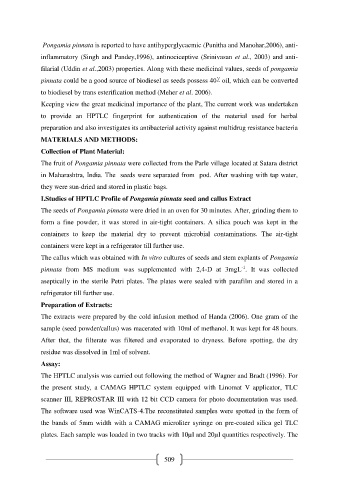Page 519 - e-Book
P. 519
Pongamia pinnata is reported to have antihyperglycaemic (Punitha and Manohar,2006), anti-
inflammatory (Singh and Pandey,1996), antinociceptive (Srinivasan et al., 2003) and anti-
filarial (Uddin et al.,2003) properties. Along with these medicinal values, seeds of pongamia
pinnata could be a good source of biodiesel as seeds possess 40٪ oil, which can be converted
to biodiesel by trans esterification method (Meher et al. 2006).
Keeping view the great medicinal importance of the plant, The current work was undertaken
to provide an HPTLC fingerprint for authentication of the material used for herbal
preparation and also investigates its antibacterial activity against multidrug resistance bacteria
MATERIALS AND METHODS:
Collection of Plant Material:
The fruit of Pongamia pinnata were collected from the Parle village located at Satara district
in Maharashtra, India. The seeds were separated from pod. After washing with tap water,
they were sun-dried and stored in plastic bags.
I.Studies of HPTLC Profile of Pongamia pinnata seed and callus Extract
The seeds of Pongamia pinnata were dried in an oven for 30 minutes. After, grinding them to
form a fine powder, it was stored in air-tight containers. A silica pouch was kept in the
containers to keep the material dry to prevent microbial contaminations. The air-tight
containers were kept in a refrigerator till further use.
The callus which was obtained with In vitro cultures of seeds and stem explants of Pongamia
-1
pinnata from MS medium was supplemented with 2,4-D at 3mgL . It was collected
aseptically in the sterile Petri plates. The plates were sealed with parafilm and stored in a
refrigerator till further use.
Preparation of Extracts:
The extracts were prepared by the cold infusion method of Handa (2006). One gram of the
sample (seed powder/callus) was macerated with 10ml of methanol. It was kept for 48 hours.
After that, the filterate was filtered and evaporated to dryness. Before spotting, the dry
residue was dissolved in 1ml of solvent.
Assay:
The HPTLC analysis was carried out following the method of Wagner and Bradt (1996). For
the present study, a CAMAG HPTLC system equipped with Linomat V applicator, TLC
scanner III, REPROSTAR III with 12 bit CCD camera for photo documentation was used.
The software used was WinCATS-4.The reconstituted samples were spotted in the form of
the bands of 5mm width with a CAMAG microliter syringe on pre-coated silica gel TLC
plates. Each sample was loaded in two tracks with 10µl and 20µl quantities respectively. The
509

